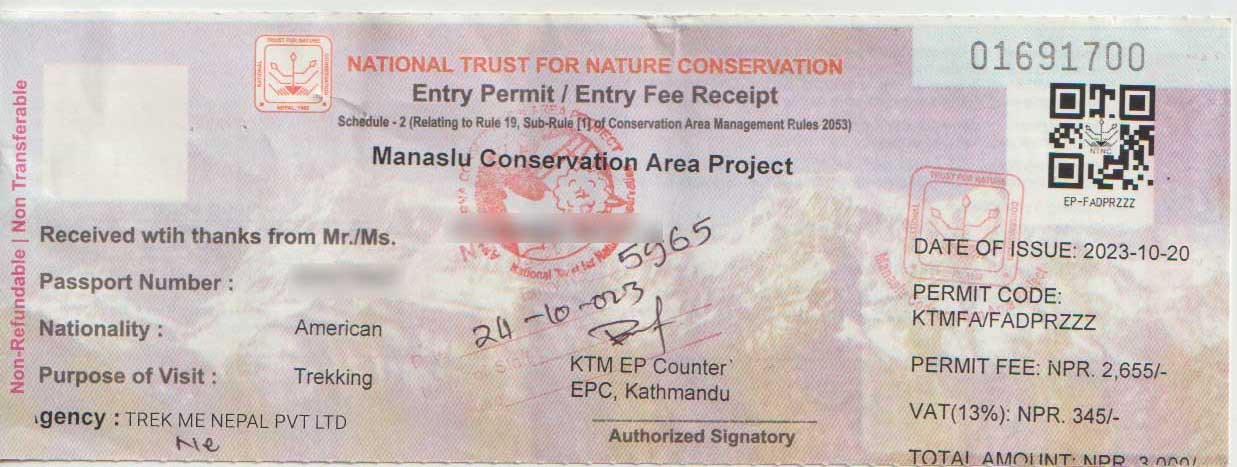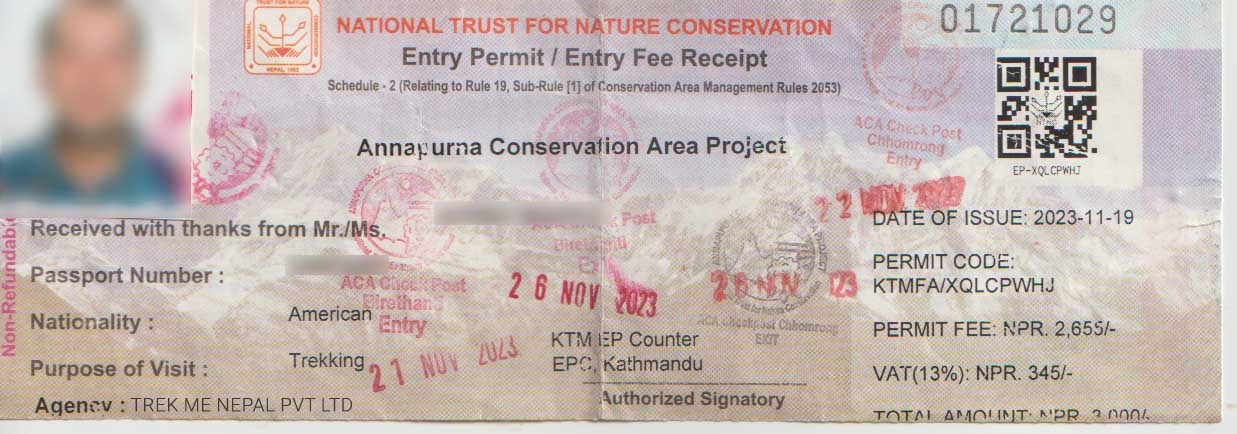

The Manaslu Circuit Trek is a remote and culturally sensitive route in Nepal, circling Mount Manaslu (8,163m), the world’s eighth-highest peak.
Unlike more commercialized trails like Everest or Annapurna, Manaslu remains a restricted and protected zone, requiring trekkers to obtain mandatory permits to ensure environmental conservation, cultural preservation, and controlled tourism.
Without proper permits, trekkers risk being turned back at checkpoints (e.g., Jagat, Dharapani, or Samdo), where officials verify documents. Compliance ensures a seamless trek while contributing to the region’s sustainability.
Note: All permits for the Manaslu Circuit Trek can be arranged through Trek Me Nepal, ensuring full compliance with government regulations.
To trek the Manaslu Circuit legally, you must obtain several permits, each serving a distinct purpose based on the region’s conservation status and government regulations. Below is a detailed breakdown of all mandatory permits, their coverage, and associated costs.
Purpose: Required for entry into the Manaslu Restricted Zone, a controlled area near the Tibet border with limited access to protect cultural and geopolitical sensitivities.
Validity: Issued for a specific duration (typically matching your trek itinerary).
Things to Note:

Purpose: Funds conservation efforts in the Manaslu Conservation Area, covering biodiversity protection and sustainable tourism initiatives.
Validity: Single-entry permit valid for the entire trek duration.
Things to Note:

Purpose: Required for the section of the Manaslu Circuit that overlaps with the Annapurna Conservation Area (e.g., Dharapani to Besishahar).
Validity: Single-entry permit valid for the duration of the trek.
Things to Note:
Purpose: Required only if adding the Tsum Valley detour, a culturally restricted zone with ancient Tibetan Buddhist villages.
Validity: Duration-specific, similar to MRAP.
Things to Note:
Purpose: A local permit introduced in recent years, funding rural infrastructure projects in the Chumnubri region (part of the Manaslu trek route).
Things to Note:
| Manaslu Restricted Area Permit (MRAP) | |||
| Season | Duration | Cost (USD) | Cost (NPR) |
| Peak (Sep-Nov, Mar-May) | First 7 days | $100 | ≈13,300 |
| Each additional day | $15 | ≈2,000 | |
| Off-Peak (Dec-Feb, Jun-Aug) | First 7 days | $75 | ≈10,000 |
| Each additional day | $10 | ≈1,330 | |
Key Notes:
| Category | Cost (NPR) | Cost (USD) | Validity |
| Foreigners | 3,000 | ≈23 | Entire trek |
| SAARC Nationals | 1,000 | ≈8 | Entire trek |
Key Notes:
| Category | Cost (NPR) | Cost (USD) | Validity |
| Foreigners | 3,000 | ≈23 | Entire trek |
| SAARC Nationals | 1,000 | ≈8 | Entire trek |
Key Notes:
The Tsum Valley extension requires additional permits separate from standard Manaslu Circuit permits. This remote area has special protection due to its cultural significance and border proximity.
Season | Duration | Cost (USD) | Cost (NPR) |
| Peak (Sep-Nov, Mar-May) | First 7 days | $40 | ≈5,300 |
| Each additional day | $7 | ≈930 | |
| Off-Peak (Dec-Feb, Jun-Aug) | First 7 days | $30 | ≈4,000 |
| Each additional day | $7 | ≈930 |
Key Notes:
| Category | Cost (NPR) | Cost (USD) | Validity |
| All Trekkers | 2,000 | ≈15 | Entire trek |
Key Notes:
What’s Covered by Permit Fees:
What’s NOT Covered:
Minimum group size: 2 trekkers (solo travelers must join a group).
Mandatory costs:
Note: Permit fees are fixed per person; guide costs are additional.
Obtaining the necessary permits for the Manaslu Circuit Trek involves specific procedures and authorized channels. Below is a comprehensive guide to acquiring all required permits through proper channels.
The Manaslu Restricted Area Permit (MRAP) and Tsum Valley Restricted Area Permit can only be obtained through government-registered trekking agencies in Nepal. These agencies must be:
Key Points:
Individual trekkers cannot apply directly for restricted area permits
Agencies handle the entire application process on your behalf
They submit the required documents to the Department of Immigration
For conservation area permits (MCAP and ACAP), you have more options:
In Kathmandu:
In Pokhara:
Processing Times
MRAP: 1 business day (through agency)
MCAP/ACAP: Immediate issuance during office hours
| Location | Permits Available | Best For | Processing Time |
| Kathmandu | All permits (via the agency for restricted permits) | Trekkers starting directly to Manaslu | 1 day for the full set |
| Pokhara | Only MCAP and ACAP | Those acclimatizing in Pokhara first | Immediate |
Important Notes:
All permits require:
Special Requirements:
Choose Authorized Agency: Select a registered trekking company
Submit Documents: Provide all required paperwork to the agency
Payment: Pay permit fees to the agency (USD or NPR)
Agency Processing: They submit to the Department of Immigration
Collection: Agency collects permits (1-2 business days). Verification: Check all details are correct before the trek
Timeline Recommendations
The permits for the Manaslu Circuit Trek come with strict legal requirements set by the Nepalese government. Failure to comply can result in fines, expulsion from the trek, or legal action.
Rule: A minimum of 2 foreign trekkers is required to obtain the Manaslu Restricted Area Permit (MRAP).
Exception: Solo trekkers must join an existing group through a registered agency.
Verification: Checkpoints will confirm group size at Jagat, Samagaun, and other stops.
Reason:
Requirement: All trekkers must hire a government-licensed guide registered with the Nepal Tourism Board.
Guide Qualifications:
Permits are verified at multiple checkpoints.
| Checkpoint Location | Permits Verified | Additional Checks |
| Jagat (entry point) | MRAP, MCAP | Group size, guide verification |
| Deng | MRAP, MCAP | Passport matching |
| Samagaun | MRAP, MCAP | Trekking Agency details |
| Samdo (near the Tibet border) | MRAP | Special border zone clearance |
| Dharapani (exit to Annapurna) | ACAP | Conservation fee validation |
Procedure at Checkpoints:
Permit Validity:
Restricted Areas:
Environmental Rules:
The Nepalese government maintains strict policies regarding modifications to trekking permits. Understanding the regulations for extensions, refunds, and changes is essential for trekkers planning the Manaslu Circuit.
Extensions are only possible for the Manaslu Restricted Area Permit (MRAP) and Tsum Valley Permit, and must be processed before the original permit expires.
To extend a permit, your guide must first notify the registered trekking agency, which will then submit a formal request to the Department of Immigration in Kathmandu. The process takes 1-2 business days and requires payment of additional fees at the same daily rate as the initial permit.
Extensions are limited to a maximum of 7 additional days and are subject to approval. Conservation permits (MCAP and ACAP) cannot be extended under any circumstances, meaning trekkers would need to purchase new permits if their plans change.
It's important to note that no on-the-spot extensions are granted at trail checkpoints.
All permits for the Manaslu Circuit Trek are non-refundable once issued, with very few exceptions. Partial refunds may be available if a trek is cancelled before the permit has been issued, though agencies typically retain a processing fee.
In cases of government-ordered trail closures due to natural disasters or other emergencies, trekkers may receive prorated refunds for unused days, but this requires official documentation of the closure.
Medical emergencies may qualify for partial refunds (typically 50-80%) but require submission of hospital reports and other supporting documents to immigration authorities.
No refunds are provided for changes of mind after permit issuance, incomplete treks due to personal reasons like altitude sickness, or lost/damaged permits.
Changes to trek dates are possible before permit issuance with at least 72 hours notice and no additional fees. However, after permits have been issued, any changes to restricted area permits (MRAP and Tsum Valley) require purchasing new permits at full cost, as the original permits become invalid.
Conservation permits (MCAP and ACAP) may be reused if the new trek dates fall within the original validity period. Route modifications, such as adding Tsum Valley to an itinerary, always require a new permit application. Reducing the trek duration forfeits any unused days without refund.
Lost or damaged permits can be replaced by submitting a police report (for lost permits) and an official letter from the trekking agency explaining the circumstances. The replacement fee is NPR 5,000 (approximately $38 USD) per permit, and processing takes one business day in Kathmandu.
Damaged permits must be surrendered when applying for replacements. Trekkers should note that digital copies or photos of permits are not accepted at checkpoints, so physical copies must be carried at all times.
Planning trek dates carefully is crucial, as changes after permit issuance are costly and time-consuming. Travel insurance is highly recommended to cover non-refundable permit costs in case of unexpected changes.
Working with a licensed trekking agency like Trek Me Nepal ensures proper handling of administrative issues and compliance with all regulations.
Several misconceptions persist about Manaslu trekking permits.
Fact: The Manaslu Restricted Area requires:
Minimum 2 trekkers per group
Government-licensed guide at all times
Solo travelers must join existing groups through registered agencies.
Fact: The Trekkers' Information Management System (TIMS) card:
Not valid for Manaslu Restricted Area
Separate MRAP/MCAP permits remain mandatory
Only applies to non-restricted trekking regions
Fact: While permit costs are lower, December-August:
Same documentation required
Identical group/guide regulations apply
Checkpoints remain operational year-round
Red flags include:
Note: Trek Me Nepal holds valid NTB/TAAN accreditation for transparent permit processing.
Ans: No. The Restricted Area Permit requires a minimum of 2 trekkers and a licensed guide at all times. Solo travelers must join a group.
Ans: No. Restricted Area permits must be processed physically through registered agencies in Kathmandu. Only conservation permits (MCAP/ACAP) can be obtained at NTB offices.
Ans: You must file a police report and pay NPR 5,000 per permit for replacement through your agency. Digital copies aren't accepted at checkpoints.
Ans: At every major checkpoint (Jagat, Deng, Samagaun, Samdo). Officials verify permits, passport details, and guide credentials.
Ans: Only Restricted Area permits (MRAP/Tsum) can be extended, requiring agency processing in Kathmandu before expiration. Conservation permits cannot be extended.
Ans: Minimum NPR 25,000 fine, immediate trek termination, and possible deportation. Checkpoints strictly enforce regulations.
Ans: No. All permits are non-refundable after issuance, except for government-ordered trail closures with official documentation.
Trek Me Nepal Archives
Check out recent travel trends and news by Trek me Nepal
More Reasons Why Travellers Trust Us
Laxu Sapkota
General Manager
Laxu Sapkota views travel as his lifelong calling. Born and raised in the heritage-rich Kathmandu Valley, his earliest memories are tied to the breathtaking sights of white mountain peaks in the north... Read More